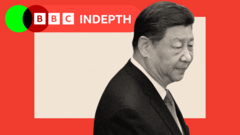In the bustling trade hubs of China, the mention of Donald Trump often garners laughter rather than fear, as the U.S. president's 145% tariffs have spurred an army of online nationalists creating humorous content, including AI-generated depictions of Trump working in Chinese factories. This reaction reflects a broader sentiment within China: a belief that they are less vulnerable to U.S. economic pressure than in previous years.
President Xi Jinping’s message has been resolute; he insists on China’s longstanding reliance on self-reliance and industriousness. "For more than 70 years, China has always relied on self-reliance and hard work… it has never relied on anyone’s gifts and is unafraid of any unreasonable suppression," he stated earlier this month. The current situation, however, is complicated by pressing economic concerns internal to China, such as a significant housing crisis and stagnating consumer spending, exacerbated by the trade tensions with the U.S.
China's domestic economy is grappling with challenges that have roots beyond Trump's economic policies. A continuing collapse in the housing market has left many families, who invested heavily in property, disillusioned as market values plummet, leading to a ripple effect on consumer confidence. Reports suggest enough vacant housing exists to accommodate three billion people – a stark representation of overbuilding and a lack of buyers, with rising debts contributing to investor apprehension.
The economic landscape is further strained by alarming unemployment rates, especially among young individuals, with over 20% of urban youth unable to find jobs, and worries among families regarding the viability of future pensions as a large segment of the population ages out of the workforce.
As products traditionally sent to U.S. markets accumulate under tariffs, experts pointedly note that shifting to domestic consumption is not an immediate solution. "Given the downward pressure on the economy, it is unlikely domestic spending can be significantly expanded in the short term," states Renmin University’s Prof. Nie Huihua. In efforts to revitalize the economy, the government is rolling out initiatives like childcare subsidies and discounts on consumer goods, however, many argue that these measures are stopgaps rather than sustainable solutions.
Consequently, Xi is faced with the dual challenge of maintaining the Communist Party’s credibility while revitalizing a disillusioned younger generation. Recent reports highlight a sharp rise in protests fueled by economic discontent, though these are frequently suppressed before escalating into significant threats against Xi’s administration.
Amid these trials, Xi aims to pivot to advanced manufacturing and diversification of trade relationships, seeking to expand connections outside of the U.S. market. Initiatives like the Belt and Road plan exemplify these efforts, with China deepening ties across Southeast Asia, Latin America, and Africa, positioning itself as a resilient alternative to the U.S. in global trade.
Despite these ambitions, apprehensions about possible trade frictions created by an influx of goods into neighboring markets persist, especially given China’s recent history of imposing trade restrictions on other nations. As economic pains persist, Xi hopes to leverage the current climate, positioning China as a leading trade player even while acknowledging the underlying vulnerabilities present at home.
In the larger context of U.S.-China relations, Xi's strategy might be viewed as a test of durability against the backdrop of Trump’s tariffs, which some analysts argue might eventually shift to a more conciliatory stance. As Chinese social media reflects high hopes for political shifts, the reality remains that China’s next moves will ultimately be determined by its own policy reforms rather than external pressures, challenging Xi to introspectively address the weaknesses revealed by this trade war.




















